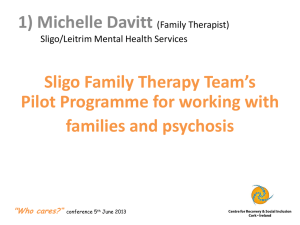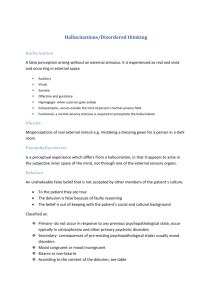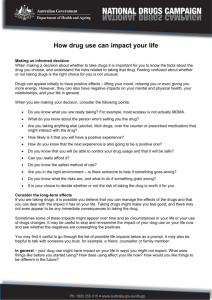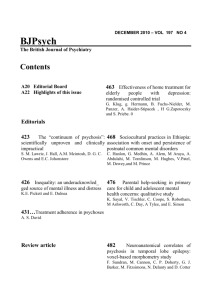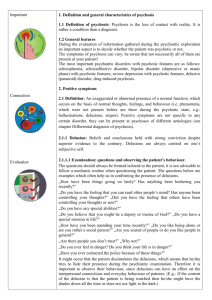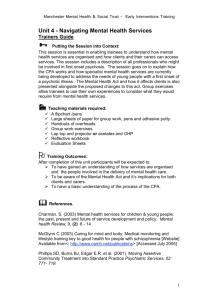Models of Psychosis and Psychiatrists' Views of the Mind
advertisement
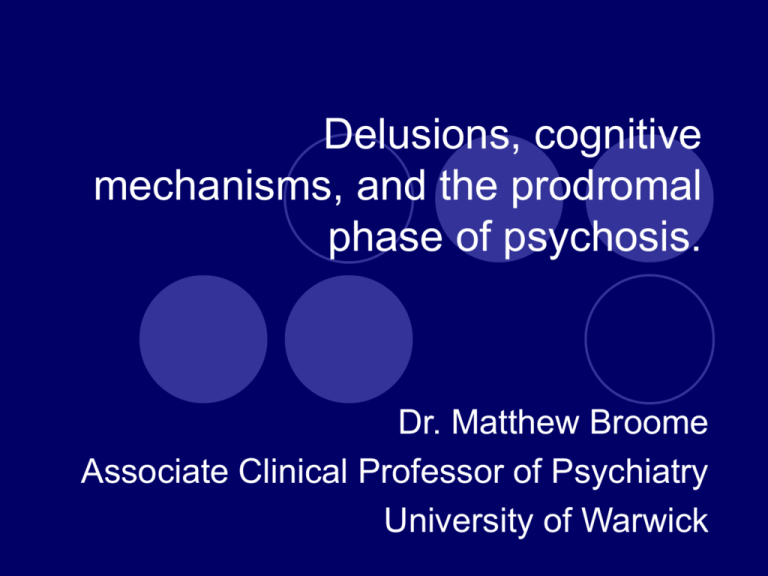
Delusions, cognitive mechanisms, and the prodromal phase of psychosis. Dr. Matthew Broome Associate Clinical Professor of Psychiatry University of Warwick Content of talk Psychosis, delusions, and schizophrenia: some clinical psychiatry The science of psychosis: neurodevelopment and dopamine Cognitive models of delusions and relationship to neuroscience Data of cognitive biases related to delusion formation in prodromal sample. Psychosis Mental disorder in which the thoughts, affective response or ability to recognize reality, and ability to communicate and relate to others are sufficiently impaired to interfere grossly with the capacity to deal with reality; the classical characteristics of psychosis are impaired reality testing, hallucinations, delusions, and illusions. DSM IV on psychosis ‘disorders in this section are all characterized by having psychotic symptoms as defining feature’. ‘the term psychotic has historically received a number of different definitions,[…]. The narrowest definition of psychotic is restricted to delusions or prominent hallucinations, with the hallucinations occurring in the absence of insight into their pathological nature’. DSM IV on psychosis ‘A slightly less restrictive definition would also include prominent hallucinations that the individual realizes are hallucinatory experiences. Broader still is a definition that includes other positive symptoms of schizophrenia (i.e., disorganized speech, grossly disorganized or catatonic behaviour.)’ Delusions ‘A delusion is a false, unshakeable idea or belief which is out of keeping with the patient’s educational, cultural and social background; it is held with extraordinary conviction and subjective certainty’ (Sims, 1995). ‘A delusion is a belief that is firmly held on inadequate grounds, is not affected by rational argument or evidence to the contrary, and is not a conventional belief that the person might be expected to hold given her educational, cultural, and religious background’ (OTP, 2006). Classifying delusions Primary (‘delusions’) vs secondary (delusion-like) Schneiderian Theme Degree of conviction/fixity – partial, complete. Jaspers on delusions 1913 Verstehen Dilthey’s hermeneutics ‘interpretative understanding’ ‘empathy’. Primary – un-understandable, psychologically irreducible. Secondary/delusion-like – understandable, arise from other psychic phenomena Schneiderian symptoms FRS If occur in absence of coarse brain disease, then will call it Schizophrenia. 2nd rank symptoms also allow diagnosis of Schizophrenia if ‘certain combinations or numbers’. Emphasises that although recovery can occur, exceptional. Schneider’s First Rank Symptoms Thought echo 3rd person auditory hallucinations/commentary Somatic hallucinations Thought withdrawal or insertion Thought broadcasting Delusional perception Made feelings/acts Typical contents and themes Persecution Reference Grandiose Guilt Hypocondriacal Nihilistic (Cotard’s) Religious Delusional misidentification (Capgras, Fregoli). Jealous (Othello) Sexual/amorous (erotomania – de Clerembeault’s) Dysmorphophobia Delusions of control (passivity) Thought withdrawal, thought insertion, thought broadcasting Clinical features of Schizophrenia Defined largely by duration of illness (6/12 or 1/12 depending on DSM/ICD) Course of illness over time Presence of certain psychotic symptoms (weighted towards FRS) Absence of prominent mood disorder Absence of medical/organic illness causing psychosis. DSM IV Sz 1 of bizarre delusions or Schneiderian hallucinations or 2 of delusions, hallucinations, disorganized speech/behaviour, negative features. + social/occupational dysfunction 6/12 duration Exclude: mood disorder, substance abuse, PDD. ICD-10 Sz 1 Schneiderian delusion/hallucinations or 2 of hallucinations, disorganized speech, negative features, catatonic features. 1/12 duration Exclude: mood disorder, substance abuse, PDD, organic brain disease. Neurodevelopmental Model Weinberger in US and Murray in UK ‘genes involved in neurodevelopment and/or environmental insults in early life lead to aberrant brain development, which in turn predisposes to the later onset of psychosis’ ‘doomed from the womb’ Therapeutic pessimism, palliative psychiatry Neurodevelopmental model Dominant paradigm guiding research since 1980’s. Sz result of abnormal brain development, this in turn secondary to genetic predisposition and early environmental factors. Ventricular enlargement static, altered cytoarchitecture and absence of gliosis suggests prenatal. Children who go on to develop Sz have impaired motor, intellectual, behavioural development. Signs pre-onset Developmental milestones Social interaction – solitary and anxious Cognitive impairments Quasi-psychotic symptoms in childhood Challenges to the orthodoxy Social factors: urban upbringing, migration, bullying, racism, childhood sexual abuse, absent father. Continuum – factors associated with Sz also associated with psychotic experiences in normal population (single, urban, unemployed, cannabis, low IQ, poorer education, cannabis, alcohol, life events). ‘prodrome’ – helpseeking, symptoms, but not ‘case’. % of population General Population Risk for Psychosis General Population At risk group Psychosis group Vulnerability to Psychosis Problem of onset What converts developmentally impaired, socially isolated adolescent with odd ideas and experiences into a psychotic individual? Depression? Intensity? Neuropsychology? Cognitive schema and appraisal. Dopamine as the ‘wind of the psychotic fire’: salience Hemsley, Gray, and Kapur ‘meaningful connections are created between temporary coincident external impressions or perceptions with thoughts that happen to be present, or events and recollections happening to occur at the same time’ ? Early 90’s Gray, Hemsley posited that hippocampal damage would lead to dysregulation of mesolimbic dopamine system, and the false creation of ‘meaningful connections’ between coincident events. Dopamine and normal mental life Mesolimbic dopamine provides significance or salience. Transforms an affectively neutral mental representation of a stimulus into an attractive or aversive one. External perceptual or internal mental ‘hedonic vector’ and ‘grabs the attention’ An ‘is’ to a ‘towards which’ or ‘away from’ Psychosis and dopamine Dysregulated dopamine in psychosis Correlates with positive symptoms Correlate with response to medication (D2 antags). Psychosis increased, stimulusindependent release of dopamine leading to salience being granted to otherwise innocuous stimuli Psychosis and dopamine In psychosis, cortico-limbic malfunction. Prefrontal cortex dysfunction and volume loss in amygdala and hippocampus. Excessive activity of limbic centres and loss of prefrontal ‘brake’? Increased dopamine, increased salience, paranoia and psychosis. Risk for dopamine dysregulation Genes: neuregulin, dysbindin, DISC-1, COMT. Environmental insults: hippocampal size, sensitive dopamine system. Drugs: sensitization. Social: ‘social defeat’ – animal models inc. dopamine response, macaque monkeys – isolation, social subordination. Maher and his theory of delusions ‘Basic cognitive dysfunction’ (Frith, Hemsley) first step: this leads to generation of ‘anomalous experiences’. Delusion is the result of an intact reasoning mechanism to make sense of anomalous experience. Delusion is an explanation. Two-stage model of delusions. Cognitive models and dopamine Garety ‘basic cognitive dysfunction’ – Hemsley, Frith. Generates anomalous experiences ? Cognitive parallel of increased mesolimbic dopaminergic transmission and inappropriate salience ? “my thoughts get all jumbled up … Things are coming in too fast. I loose my grip and get lost. I am attending to everything at once and as a result do not attend to anything”. MAHER (92): Perceptual anomalies Delusion Post-Maher Maher’s work huge impetus for research and therapy into the psychopathology of psychosis (Jaspers’ ‘ununderstandable’.) Current cognitive models (both theoretical and clinical) work within this model but refute the second stage (intact reasoning) and to some extent, the necessity of an anomalous experience. GARETY & HEMSLEY (94): Jump-to-conclusions data-gathering bias Basic cognitive disturbance. Delusion Perceptual anomalies Factors in stage 2 Garety: jumping to conclusions and data gathering bias. Frith: ‘theory of mind’ and deficits in metarepresentation. Bentall: appraisal, misattribution and ‘defence’ against depression. Others: social isolation, metacognition, intolerance of ambiguity. Salience of information that might potentially enter awareness is influenced by dopamine, increased dopaminergic activity will result in attention being deployed inappropriately Inappropriately salient intrusions intrude into awareness. poor contextual integration and decrease in the influence of temporal context on attentional control. Thus, theories implicating impaired contextual integration and abnormal appraisal on the one hand and dopamine dysregulation on the other may be attempts at explaining the same processes at the different levels of informationprocessing and neurochemistry respectively. Cognitive biases and delusion formation in the at-risk mental state . Reasoning biases and anomalous experiences Crucial role of appraisal of experience in onset of psychosis. Cognitive model of psychosis Reasoning bias: data from at-risk group Correlations with bias in this group. Cognitive Model • reasoning & attributional biases • dysfunctional schemas of self & world • isolation & adverse environments Event or Trigger Basic cognitive Appraisal dysfunction Emotions Behaviour Physical sensations A Cognitive Model of the Positive Symptoms of Psychosis (Garety et al 2001) Bio-psychosocial vulnerability Trigger Basic cognitive dysfunction Anomalous experience Appraisal influenced by: • reasoning & attributional biases • dysfunctional schemas of self & world • isolation & adverse environments Emotional changes Appraisal of experience Maintaining factors • reasoning & attributions • dysfunctional schemas • emotional processes • appraisal of psychosis Positive Symptoms Data Gathering Bias in ARMS (1) ‘jumping to conclusions’ style of thinking in patients with delusions in context of schizophrenia Data gathering bias – reach decision with less evidence. Beads task Jumping to conclusions ? Which jar are the beads coming from? Data gathering bias in ARMS (2) ARMS useful group: actively experiencing anomalous experiences but not fully psychotic or deluded. Hypothesis a): data gathering bias predates onset of delusions Hypothesis b): such a bias is related to either working memory dysfunction or personality style OASIS (Outreach And Support in South London) •Outreach service for people (14-35 yrs old) with ‘at risk’ symptoms •Primary Care setting (improve access & avoid stigmatisation) •Designed to –Reduce ‘at risk’ symptoms and disability –Prevent transition to psychosis –Improve outcome if psychosis develops Typical ‘prodromal’ signs ‘Attenuated’ psychotic symptoms Recent decline in function Depressive and anxiety symptoms Very high risk of psychosis: 40% within 12 months Data Gathering Bias in ARMS – measures/tasks IQ – Quick and NART Peters Delusion Inventory (PDI) Computerised version of beads task 85:15, 60:40, 44:28:28. Pseudo-random playlist. Jars of beads used in explaining task. Psychopathology in ARMS included PANSS, Ham-A, Ham-D, Young’s Mania Scale, SAPS delusion subscale. Kruglanksi Need for Closure Freeston Intolerance of Uncertainty Methods ‘Memory beads’ – hopefully analogue of digit span. 10 trials of strings of beads to recall – differing length (5-9) and containing beads of different colours. Errors and span. ‘n-back’ – 0-back: attention, 2-back: working memory. Data gathering bias in ARMS: Results I - demographics Controls ARMS No. subjects 23 35 Age (mean) 25.1 24.2 IQ NART Mean (SD) 110.9 (3.0) 102.3 (4.3) 60 green 40 purple (Mainly green jar) 60 purple 40 green (Mainly purple jar) 60 green 40 purple 60 purple 40 green (Mainly green jar) (Mainly purple jar) The first bead is Do you want to see more beads or to decide now? The second bead is Do you want to see more beads or to decide now? The third bead is Do you want to see more beads or to decide now? The fourth bead is Do you want to see more beads or to decide now? Data gathering bias in ARMS Results II – beads task Control ARMS Significant? Easy (85:15) 6.4 7.4 N Intermed (60:40) 13.4 8.5 Y – p < 0.001 Hard (44:28:28) 17.5 12.5 Y – p 0.012 Jumping to conclusions in the predelusional? 18 16 * 14 12 ** 10 Control ARMS 8 6 4 2 0 85:15:00 **<.01 * <.05 60:40:00 44:28:28 Data Gathering Bias in ARMS (5) Results – PDI and personality traits Controls ARMS Significant PDI total 29.2 99.0 p < .001 PDI distress 9.0 34.4 p < .001 PDI preoccupation 8.7 32.4 p < .001 PDI conviction 11.5 32.1 p < .001 NFC total 10.9 11.6 NS NFC decisiveness 4.0 2.4 p= .019 NFC discomfort with 4.3 ambiguity 6.0 p= .007 NFC closed mindedness 2.6 3.2 NS Intolerance of Uncertainty 58.3 80.8 p <.001 Results - Correlations beads 60:40 PDI total All subjects -0.334 p=.019 PDI distress All subjects -0.282 p=.049 PDI preoccupation PDI conviction Intolerance of Uncertainty Memory beads Memory beads All subjects -0.331 p=.020 All subjects -0.373 p= .008 All subjects -0.285 p=.049 Controls + 0.444 p=.031 ARMS - 0.451 p=.027 Conclusions Data gathering bias predates onset of psychosis and formation of delusions. Correlates with Intolerance of Uncertainty in both groups. Relationship with working memory differs in groups: memory error in controls leads to increased conservatism, in ARMS increased JTC bias. Intolerance of Uncertainty: correlates with bias Jumping to conclusions Working memory errors in controls -Decreases bias Positive correlation Working memory errors in ARMSIncreases bias Negative correlation Summary Delusions are hard to define and heterogeneous but an essential part of what psychosis means and the criteria for the diagnosis of schizophrenia. Gradual merging of social, biological, and cognitive accounts of pathophysiology. Empirical data suggests that cognitive biases exist prior to onset of psychosis and development of delusions. OASIS Clinical and Research Team and co-investigators Sagnik Bhattacharyya Elvira Bramon Caroline Brett Fern Day Philippa Garety Oliver Howes Louise Johns Philip McGuire Emmanuelle Peters Corinne Prescott Paul Tabraham Isabel Valli Lucia Valmaggia James Woolley
